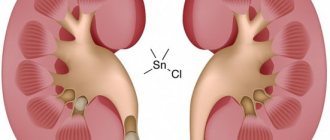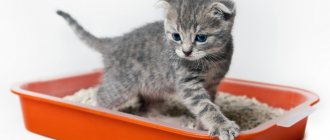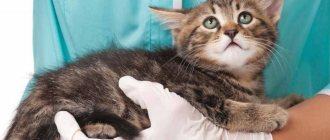The presence of scarlet drops or streaks in the feces is a signal that something is wrong in the cat’s body. This alarming symptom should not be ignored. After all, inaction can lead to severe internal bleeding and death of the pet. Therefore, it is important to understand the reasons for the appearance of blood in feces and in what cases the cat will need emergency hospitalization, and when treatment can be carried out at home.
Why does a cat poop blood?
The appearance of blood in the stool is a symptom of the following diseases or pathological conditions:
- Infectious diseases.
- Helminthic or protozoal parasites.
- Poisoning with hemolytic poisons.
- Side effects of medications.
- Allergic reaction to food components.
- Mechanical damage due to constipation or inedible objects getting inside.
- Intestinal obstruction or obstruction.
- Diseases of the hematopoietic organs.
- Stomach or duodenum ulcer.
- Inflammatory bowel diseases.
- Pancreatitis, hepatitis, other chronic pathologies.
- Lack of water when feeding dry pellets.
Preventive actions
It is easier to prevent any disease than to deal with its consequences later. To prevent the appearance of bloody discharge in cat feces, you need to follow a number of important rules:
- Organize a balanced diet - choose the most suitable food for your cat and control the portion size.
- Systematically carry out deworming.
- Avoid contact with street animals.
- Make sure your cat always has clean drinking water.
- Consider taking multivitamin complexes prescribed by the doctor.
- In case of development of diseases of the pancreas or liver, hepatoprotectors and enzymes will need to be taken several times a year (as recommended by a veterinarian).
- When treating a room for rodents, special care should be taken to prevent possible poisoning.
- With increased food hypersensitivity, a cat may experience problems with intestinal microflora. In this case, the doctor prescribes probiotics.
Bloody stool in a cat is an alarming sign that should not be ignored. Timely recognition of the problem and properly prescribed treatment can quickly return your pet to its normal state.
Description of blood in stool, depending on the cause
First of all, you should make sure that the cause of the change in stool color is blood. Adherents of natural nutrition are frightened by the red-brown color of feces when including large amounts of beets and other dark-colored vegetables in the diet. If foods rich in pigments are excluded from the diet, the cause of the change in stool color can be determined.
There is a distinction between latent and obvious blood. If the outlet is smeared and tarry, it means bleeding occurs in the initial parts of the gastrointestinal canal and has been exposed to digestive enzymes.
Brown-black feces, called melena, are completely washed away with water without sediment. However, it should be noted that feces acquire a black color after feeding with activated carbon.
Obvious blood or hematochezia is noticed when examining the fecal matter. In this case, the source of hemorrhage is located behind the duodenum.
Be sure to read:
What to do if a kitten cannot poop, how to understand that a cat is constipated?
Single drops indicate a scratch or crack in the anal sphincter. The feces acquire a burgundy or red-brown color when the source of bleeding is located in the initial segment of the large intestine.
Cherry or crimson coloring indicates hemorrhage in the rectum or posterior colon. Red stools with diarrhea cannot indicate the place where the bleeding occurred due to the high speed of passage of fecal matter.
Doctors on the staff of “I-VET” to answer why a kitten has diarrhea and in other situations
The veterinary is one of the few in the capital that can boast of having highly specialized specialists. We have the following professionals in our arsenal:
- gastroenterologist;
- dentist;
- gynecologist for dogs and cats;
- ratologist;
- ophthalmologist;
- neurologist;
- nephrologist;
- many other specialists who are ready to help with the most exotic animals that can only exist on our planet.
Such a variety of specialists will allow you to receive first-class assistance at any time. Even if you call us late at night, specialists will arrive promptly, within 40 minutes maximum, and help solve all problems related to your pet’s health as quickly as possible.
Many consider calling a veterinarian to your home a fad for the rich, however, for example, with diarrhea, this can be an invaluable help that will help quickly, easily and safely for others to help your pet.
Actions before visiting a veterinary clinic
An emergency situation in which the cat must be taken to the clinic immediately occurs when there is significant blood loss, characterized by the following symptoms:
- profuse hematochezia or melena;
- vomiting black coffee-colored contents;
- depression, shortness of breath, loss of consciousness.
In such a situation, the cat must be taken to the clinic in your arms, head down, so that oxygen starvation of the brain does not develop. Frozen meat from the refrigerator is placed on the stomach.
If one or several drops of scarlet blood appear on the surface of formed feces, you can treat the anus with antiseptic ointment. If constipation is suspected, Vaseline oil is used. Vegetable oils help eliminate stool retention, but have side effects on the liver.
When the bleeding is not profuse, the owner can try to solve the problem on his own using the following techniques:
- Deworming . Nematodes injure the mucous membrane, destroy capillaries, and droplets of blood are released. If the animal has not been dewormed for more than three months, an anthelmintic should be used.
- Change of diet. You need to stop treating your pet with food from the table, as well as treats purchased in the store. Your pet may have an allergic response to food components. If you replace ready-made economy-class food with premium ones, the problem may disappear. Dry granules enter the stomach, and if the drinking bowl is dry, they absorb moisture from the mucous membrane. In this case, trauma occurs with the destruction of small vessels.
- Cleansing the intestines from trichobezoars. Pets, especially long-haired ones, swallow hairs when licking. Hairballs form and combine with the intestinal contents. Soft stones form, blocking the intestines partially or completely. Defecation becomes difficult. The cat strains, and small blood vessels burst from overexertion. Blood flows out. Pets walking outside eat grass and vomit, causing hairballs to come out. Owners of cats who spend their entire lives in an apartment need to switch to super premium food, which contains components that prevent the formation of bezoars, or use Malt paste, which removes hairballs in feces.
- Help with dehydration. To prevent the animal from dying before the veterinarian appears, subcutaneous administration of saline or Ringer-Locke solution in unlimited quantities is allowed. Bubbles appear that quickly resolve.
Be sure to read:
Cat vomits yellow liquid: normal or pathological, first aid, what to do, best medications, diet
How is the treatment carried out?
The treatment regimen for a cat that shits blood is developed individually, taking into account the cause of this symptom. When the test results are received, the veterinarian will prescribe medications and diet.
In some cases, surgery may be necessary. Cats with severe internal bleeding are treated in a hospital setting. In other cases, therapy takes place at home.
Effective medications
Since blood in a cat’s feces can appear for various reasons, the treatment is different in each case. List of drugs that are used for various pathologies:
- helminthic infestation - Drontal, Stronghold, Pirantel;
- problems with the liver or pancreas - Pancreatin;
- colitis – Enterol, Subtilis;
- allergies – Tavegil;
- infectious diseases – Gamavit, Fosprenil, Aminovit;
- bacterial infections – Enterofuril, Furazolidone;
- dysbacteriosis – Bifidumbacterin, Linex;
- hemostatic drugs - Etamzilat or Vikasol.
If an adult animal or kitten poops blood due to rat poison poisoning, then treatment should be started immediately. It includes gastric lavage and taking sorbents such as Enterosgel. In case of severe dehydration, the cat is treated with Regidron.
If the pet cannot drink, then the water balance is restored using droppers.
Traditional treatment
Folk remedies can only be used if the cat poops blood due to constipation. Vaseline oil is usually used to loosen stools. It is not absorbed in the upper intestines, but moves through it unchanged, lubricates the intestinal walls and softens the stool.
If your cat is often constipated, you need to look for the cause. Folk remedies give a short-term effect, but do not solve the problem.
The right approach to nutrition
During treatment, it is important to change the cat's diet. The main goal of the diet is to reduce the load on the digestive organs. Veterinarians recommend switching your pet to ready-made hypoallergenic holistic or super-premium food.
Bread, bones, fatty meat and processed foods should be excluded from the diet of a cat that shits blood. For constipation, you can add a little vegetable oil to the food. It is advisable to include fermented milk products in the daily menu - classic yogurt, kefir or yogurt.
Surgical intervention
The operation is indicated if:
- polyps or other neoplasms were discovered in the gastrointestinal tract;
- the pet has swallowed a foreign object;
- the cat cannot poop due to intestinal obstruction;
- internal bleeding began.
When to seek help from a veterinarian
If drops of blood appear in the stool, pay attention to the following additional symptoms:
- the cat is depressed;
- loss of appetite;
- mucus or undigested pieces of food are found in feces;
- when defecating, the cat arches its back and meows pitifully;
- vomiting occurs periodically;
- bleeding occurred in a cat suffering from a chronic disease;
- Melena was discovered during the use of hormonal or non-steroidal anti-inflammatory drugs.
If the above additional signs are combined with the slightest hemorrhage, a visit to the veterinarian is necessary.
What is important to pay attention to?
If your cat is walking around with a lot of blood, then carefully monitor your pet's condition. Pay attention to how often blood is present in his stool: once or regularly (for example, every time he visits the litter box).
It is important to consider whether your pet's behavior changes when visiting the litter box (for example, he meows or moans loudly, his tension and anxiety are noticeable). See how much blood is released: droplets, small clots or large amounts of impurities.
Other points that are important to pay attention to:
- change in appetite
- the presence of impurities in the stool (mucus, hairballs),
- increase in body temperature,
- general condition of the pet.
Note! All this is necessary to answer all the veterinarian’s questions if necessary. Taking into account your information, he will make a diagnosis and determine effective treatment.
Preventing your cat from bleeding during bowel movements
To prevent blood from appearing in your cat’s stool, the following requirements must be met:
- provide adequate feeding with benign ready-made food or natural products;
- do not treat your pet with human food;
- carry out regular quarterly deworming;
- vaccinate pets according to the vaccination plan;
- provide free access to water;
- do not let your pets go outside hungry so that they do not eat poisoned mice;
- do not self-medicate, resort to the services of professionals.
Additional symptoms
If your cat poops blood, but other accompanying symptoms also appear, you should immediately contact a veterinarian.
Additional signs include the following:
- when defecating, the cat meows, which indicates pain;
- eats poorly or refuses food altogether;
- the pet develops apathy towards everything, he refuses active games;
- body temperature rises;
- the cat urinates frequently;
- weight decreases sharply;
- the pet drinks a lot and often;
- vomiting appears.
Any of these signs is a real stress for the cat, and if it hurts to poop, it only makes the situation worse.











